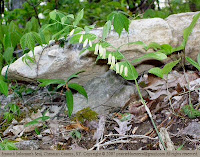More About Trees and Plants...
I recognize many wildflowers, but I don't know their names. On the other hand, I've seen and heard the names of many wildflowers, but I don't know what they look like.
Thus, when I succeed in making a new match between a wildflower and its name, I usually put it on the blog in celebration. That's the reason for this post!
 Last night, I saw an odd wildflower as I was walking with Isaac on the little road that leads through the woods.
Last night, I saw an odd wildflower as I was walking with Isaac on the little road that leads through the woods.The flower had one long arching stem with slender long alternate leaves, and it had little greenish-white bells hanging in pairs from the places where the leaves joined the stems. (This description is as scientific as you're likely to get from me.)
It took some perserverance, but I finally found it on the internet and then I could look it up in my wildflower books. It is Smooth Solomon's Seal, a woodlands wildflower.
There are several varieties of Solomon's Seal in the U.S., and this one, Smooth Solomon's Seal, can be found in the Rocky Mountains and all states eastward. It is one of three varieties of Solomon's Seal that are found in Kentucky.
The Nebraska Department of Agriculture has declared Polygonatum biflorum a weed. Each plant has just one long stem, and it can be up to three feet in length. I can imagine that a clump of this plant could create a real tangle of stems. It's not too surprising that the Solomon's Seals are closely related to the knotweeds and bindweeds.
The roots (rhyzomes) of the Solomon's Seals are used in herbal medicines, and I think that's probably where I had heard this wildflower's name previously.
The name of the Solomon's Seals probably comes from the circular scars on the root (rhyzome) where the stems of previous years have died and dropped off. These resemble the Great Seal of Solomon. Or perhaps it refers to a medicinal ability to heal ("seal") wounds.
The fruit of Smooth Solomon's Seal is a blackish berry (one berry per blossom), and it is sometimes eaten by gamebirds such as prairie chickens and wild turkeys, though it is not an important wildlife plant.
No comments:
Post a Comment